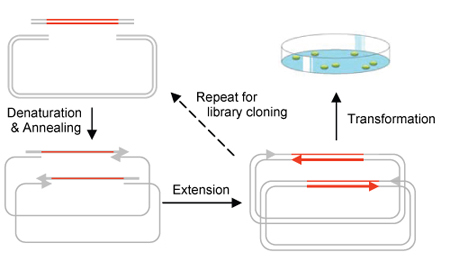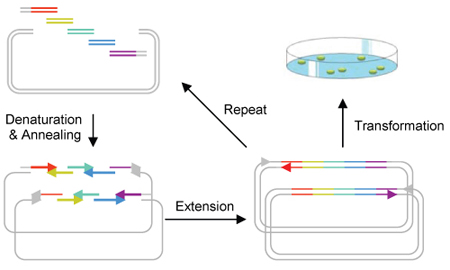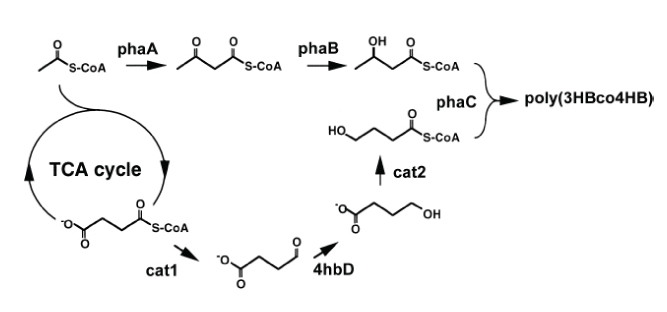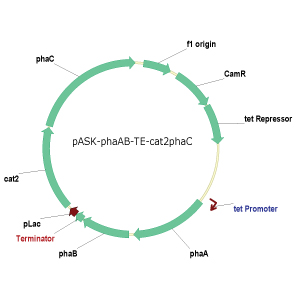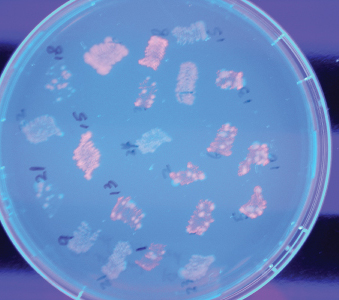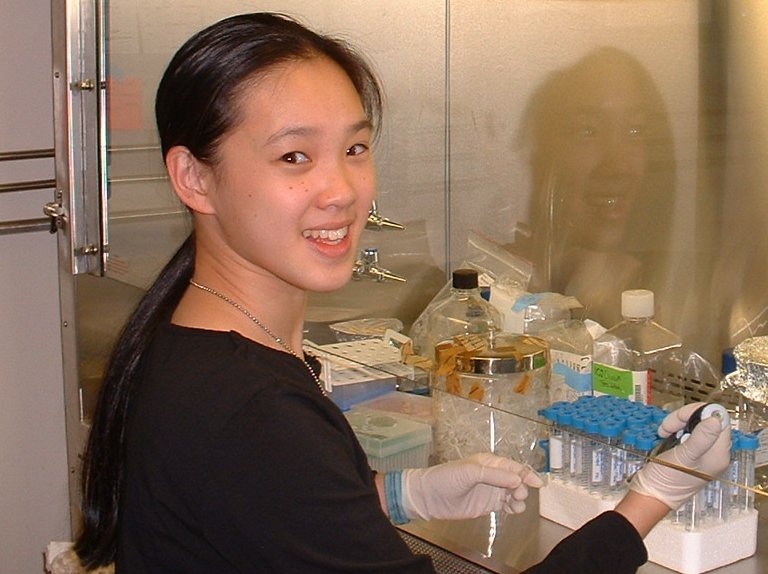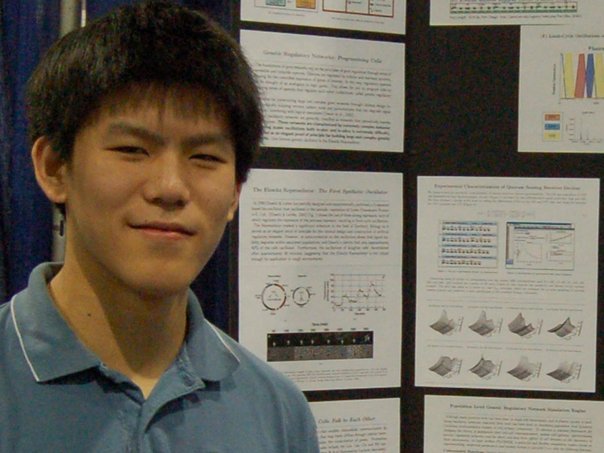Team:Duke
From 2009.igem.org
Sahilprasada (Talk | contribs) (→PCR : Phusion Polymerase) |
Sahilprasada (Talk | contribs) (→PCR : Phusion Polymerase) |
||
| Line 387: | Line 387: | ||
Resuspend the pellet by bump vortexing. | Resuspend the pellet by bump vortexing. | ||
* | * | ||
| - | Vortex with periodic pauses. Hold for 10 seconds, take it off for 1 second, and repeat for 1 minute. Hold the tube horizontally to light. | + | Vortex with periodic pauses. Hold for 10 seconds, take it off for 1 second, and repeat for 1 minute. |
| + | Hold the tube horizontally to light. | ||
If you see any clumps of cells, keep bump vortexing. Solution 1 buffer keeps cells from lysing. | If you see any clumps of cells, keep bump vortexing. Solution 1 buffer keeps cells from lysing. | ||
Suspension should be homogenous for lysis reagents. Solution 1 also contains RNase for RNA digest later on. | Suspension should be homogenous for lysis reagents. Solution 1 also contains RNase for RNA digest later on. | ||
Revision as of 08:40, 21 October 2009
| Home | Project | Notebook | Team |
Duke University's iGEM team consists of 6 undergraduate students, 2 graduate students, and 2 professors. Due to the high costs and inefficiency of the process of cloning a gene, the DUKE iGEM team has invented a new procedure which lowers costs and increases efficiency. This method, Circular Polymerase Extension Cloning* (CPEC), saves time as well, since this method does not involve ligation or restriction enzymes. The rising costs of the current method of producing biodegradable plastics has hindered its widespread use; however, this year's IGEM team has discovered a more efficient pathway to produce these biodegradable plastics. With this team's determination and motivation, they would like to present their two projects:
*This method has been published and cited. View the paper here
What is CPEC?
Circular Polymerase Extension Cloning (CPEC) is the development of a much simplified sequence-independent cloning technology based entirely on the polymerase extension mechanism. This method extends overlapping regions between the insert and vector fragments to form a complete circular plasmid. An extremely simple theory, CPEC piggybacks PCR in splicing genes. The gene insert is modified to have ends that overlap with the ends of the linearized vector and both have similar melting temperatures. The insert and vector are placed within a PCR machine in the absence of primers. Denaturation separates the double-stranded insert and vector and the overlapping ends anneal. Polymerase extension mechanism is then used to complete the plasmid. Using this method, we are able to quickly assemble a metabolic pathway consisting of multiple enzymes and regulatory elements for the production of a biocompatible as well as biodegradable plastic polymer in E. coli.
What are benefits?
The process of high-throughput cloning is bottle necked at the restriction and ligation stages. A combination of high costs, requirements for restriction site specific enzymes and general inefficiency of the process makes cloning on a large combinatorial gene library inviable. Circular Polymerase Extension Cloning (CPEC) addresses this issue by eliminating the need for restriction and ligation enzymes and thereby streamlining and condensing the procedure into the duration of 5 minutes.Advantages/Disadvantages of BioBricks
- BioBrick parts can be incorporated in E. coli , due to its common interphase.
- BioBrick parts are not easily made due to its site-specific cutting of the plasmid.
Standardized CPEC
We will apply CPEC in the construction of a multi-component plasmid containing biobricks. Previous Duke iGEM projects have yielded the genes in a metabolic pathway that synthesizes poly(3HB-co-4HB), a biodegradable plastic, in E. coli. We will transform those genes into biobricks, with sticky ends, and efficiently combine them in a vector using CPEC.Biodegradable Plastic Synthesis Pathway in E. coli
Polyhydroxyalkanoic acids (PHA), naturally occurring storage polymers found in a variety of bacteria, have received increased attention for their potential use as bioplastics that are both biodegradable and reduce reliance on petroleum-based plastics. In particular, the copolymer poly(3-hyroxybutyrate-co-4-hydroxybutyrate), or poly(3HB-co-4HB), which combines the 3HB and 4HB polymers from different bacteria (Figure 2 shows the pathway), has elastic properties ideal for a wide range of thermoplastic applications. The high cost of PHA, however, is the biggest impediment to widespread use of bioplastics. Moreover, poly(3HB-co-4HB) pathways developed so far in E. coli have yielded undesirably low and unpredictable 4HB-to-3HB ratios.
Thus, this project aims to develop a more efficient
biopathway for poly(3HB-co-4HB) while increasing the 4HB monomer composition predictably.
It was hypothesized that optimizing codon permutations of the phaC gene would
greatly increase affinity of PHA synthase to the 4HB monomer. To date, the phaCAB
and cat2 operons have been cloned into pUC19 and PCR Blunt II-TOPO vectors for
successful independent production of the 3HB and 4HB polymers (Figure 4). Ligation and transformation
into E. coli as six different recombinant constructs will soon be completed
and allow for engineering of the poly(3HB-co4HB) biopathway. Future directions
would be to test the hypothesis to see if phaC can be manipulated to increase
4HB-to-3HB composition in poly(3HB-co-4HB) and to increase efficient production
of the bioplastic by engineering the FtsZ cell division protein to allow for cells
to accumulate larger quantities of PHA granules before dividing. Ultimately, once
an optimal biopathway is found, the goal would be to explore a model for mass
production of PHA bioplastics so that novel applications of bioplastics can be
feasible economically.
| Duke University iGEM Calendar | |||||||||||||||||||||||||||||||||||||||||||||||||||||||||||||||||||||||||||||||||||||||||||||||||||||||||||||||||||||||||||||||||||||||||||||||||||||||||||||||||||||||||||||||||||||||||||||||||||||||||||||||||||||||||||||||||||||||||||||||||||||||||||||||||||||||||||||||||||||||||||||||||||
|
Below are several important milestones:
|
| ||||||||||||||||||||||||||||||||||||||||||||||||||||||||||||||||||||||||||||||||||||||||||||||||||||||||||||||||||||||||||||||||||||||||||||||||||||||||||||||||||||||||||||||||||||||||||||||||||||||||||||||||||||||||||||||||||||||||||||||||||||||||||||||||||||||||||||||||||||||||||||||||||
Contents |
Part 1
Back to top
PCR
5x HF buffer 5 ul
dNTPs 2 ul
forward primer 1.25 ul
reverse primer 1.25 ul
DNA template (plasmid) 0.5 ul
Phusion DNA polymerase 0.3 ul
H2O 14.7 ul
________________________________
25 ul
PCR : Phusion Polymerase
PCR Phusion Polymerase Reagent Amount ddH20 35ul 5xHF buffer 10ul 10mM dntps 1ul 20uM Oligo F 1.25ul 20uM Oligo R 1.25ul Template (1:20 dilution from PCR) 1ul phusion polymerase 0.5ul
Initial Denaturation 98C 30sec 1cycles Denaturation 98C 5-10s Annealing 45-72C* 10-30s 25-35 cycles Extension 72C 15-30s/kb Final extension 72C/4C 5-10min 1
Miniprep
Preliminary Steps
1.
Prepare 5 ml LB in a culture tube.
2.
Pick out and add a single colony with ~20μl pipette.
3.
Place in shaker for overnight growth. (Plasmid culture should be a typical density of A600=2.0 or higher by then)
The Procedure
1.
Label 2 2ml microcentrifuge tubes on the caps with plasmid names.
2.
Add 1.5 ml harvested culture to each of 2 tubes.
3.
Insert in microcentrifuge so that they are balanced, and the hinges face away from the center.
4.
Microcentrifuge at 15,000 rpm for 1 minute (Our centrifuge is limited to 13,000 rpm, but that is fine).
5.
Pour off supernatant.
6.
Add another ~.75 ml culture to the 2 tubes.
7.
Re-centrifuge (at same settings and positions)
8.
Pour off supernatant.
9.
Re-centrifuge
10.
Use a small volume, bore tip pipette for carefully removing supernatant.
*
The cells are pelleted. Removing all liquid is critical. It is the common cause of low yields.
Otherwise, the pellet is loose and it is difficult to remove any liquid cell lysate.
11.
Pipette 50μl solution 1 to each tube.
12.
Resuspend the pellet by bump vortexing.
*
Vortex with periodic pauses. Hold for 10 seconds, take it off for 1 second, and repeat for 1 minute.
Hold the tube horizontally to light.
If you see any clumps of cells, keep bump vortexing. Solution 1 buffer keeps cells from lysing.
Suspension should be homogenous for lysis reagents. Solution 1 also contains RNase for RNA digest later on.
13.
Check solution 2 for precipitation.
*
Solution 2 contains SDS detergent.
If precipitated, heat to 55°C-66°C for 5 minutes to dissolve, cool to room temperature, and mix.
14.
Add 100μl solution 2 to each tube.
*
Alkaline detergent lyses the cell. Then, plasmid DNA is linked to form circles. RNA is digested in this step.
15.
Invert tubes once to mix.
*
Inverting more than once contaminates plasmid, causing broken chromosomal DNA to attach to plasmid DNA.
16.
Add 325μl solution 3 to each tube.
*
Solution 3 contains potassium acetate to neutralize pH. Plasmid re-natures.
17.
Gently invert once.
18.
Centrifuge (same settings)
*
Chromosomal DNA is pelleted.
19.
Remove tubes from the centrifuge.
If the pellet is too loose or gloppy, that means the media was not completely removed and you need to start over.
If it still looks slightly loose, try centrifuging again.
20.
Label 2 spin filters on the caps.
21.
Pour clear supernatant into spin filters and throw the tubes away.
*
Decant by pouring on the side away from the hinge.
22.
Centrifuge (same settings)
*
Plasmid binds to silica membrane.
23.
Lift the plastic filter basket from the tubes and discard liquid from the bottom of the tubes.
24.
Add 300μl solution 4 into the spin filters
*
Make sure there is ethanol in it (Our kit solution has 50% ethanol).
Some companies don’t have ethanol, which is good for keeping the plasmid DNA bound
to the filter as impurities are washed.
25.
Centrifuge (same settings)
26.
Lift the plastic filter basket from the tubes and discard liquid from the bottom of the tubes.
27.
Centrifuge (same settings) for 5 seconds
28.
Get another 2 2ml microcentrifuge tubes and label caps with plasmid names, sides with the date.
29.
Insert filter baskets in new tubes.
30.
Add 50μl solution 5 or double distilled water directly to the middle of the membrane.
*
Solution 5 has some salt, which is relatively better for subsequent storage and transformation.
Water is better for subsequent PCR.
*
Plasmid DNA is eluted off the filter into the collection tube.
(it will not stay bound when there is no salt)
31.
Centrifuge (same settings)
32.
Discard filter basket and close tube lid.
33.
Store plasmid DNA at -20°C. (-80°C if you want to store for several years)
34.
(Store kit at room temperature (20°C-25°C))
Concentrating the DNA
1.
(If 50μl is too dilute for your purposes, and you want a different volume)
2.
Add 2μl 5M NaCl and mix.
3.
Add 100μl 100% cold ethanol and mix.
4.
Centrifuge 13,000 rpm for 5 minutes.
5.
Decant liquid.
6.
Dry ethanol in a speed vac.
7.
Resuspend precipitated DNA in desired volume.
Gel Electrophoresis
Table of Contents
* Making the Gel * Running the Gel * Low MW Ladder
Making the Gel
*
1% agarose
*
i.e. .50g agarose 50ml TBE in flask
*
Cook in Microwave for 1 min
*
Let it cool down a little bit
*
Add 5ul of 10mg/ml Ethidium Bromide in Gel
*
Insert the comb. Pour out the gel and put it in the fridge
Running the Gel
*
5ul DNA\1ul (6X) Loading Dye into each (small) well
o
(Dilute 1ul ladder with 4ul H20 and 1ul loading dye)
*
15ul DNA\3ul (6X) Loading Dye into each (large) well
o
(Dilute 1 ul ladder with 14 ul water and 3ul loading dye)
Low MW Ladder
*
5ul DNA\1ul (6X) Loading Dye into each (small) well
o
(Dilute .5ul ladder with 4.5ul H20 and 1ul loading dye)
*
15ul DNA\3ul (6X) Loading Dye into each (large) well
o
(Dilute .5 ul ladder with 14.5 ul water and 3ul loading dye)
|
Advisors

| Dr. Jingdong Tian jtian(at)duke.edu | 
| Dr. Lingchong You you(at)duke.edu | 
| Dr. Fan Yuan fyuan(at)duke.edu |
Graduate Students

| Maggie Jiayuan Quan jq7(at)duke.edu Graduate Student | 
| Faisal Reza faisal.reza(at)duke.edu Graduate Student |
Students
 "
"

